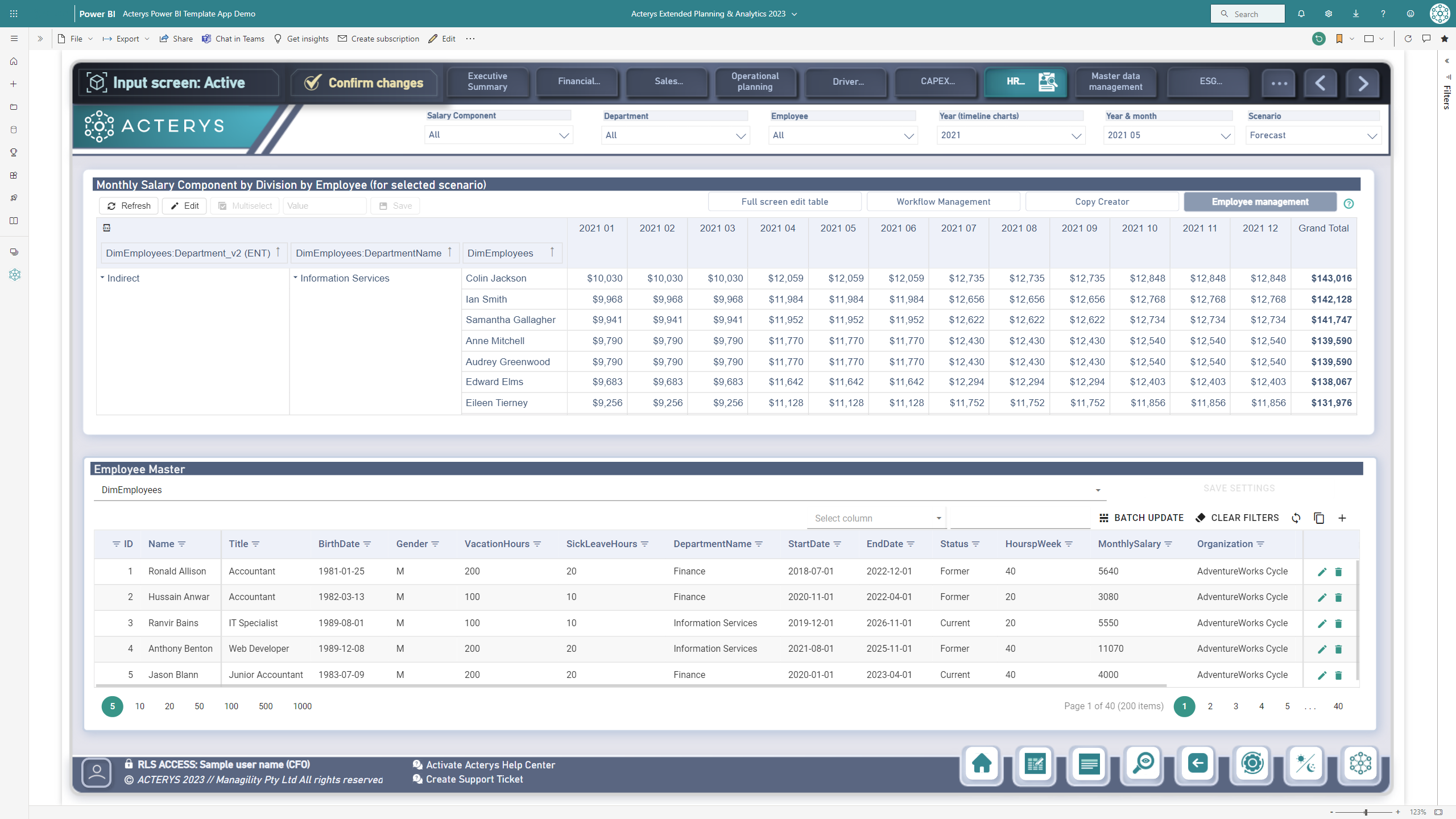
Table of Contents
Companies across industries use workforce planning tools to help them stay agile and responsive. While these tools are meant to help business leaders avoid common pitfalls like overstaffing or understaffing, there’s a notable disconnect in how they’re used.
67% of workforce planning leaders report that their organizations fail to effectively use data for workforce planning, according to research from Gartner. Although companies have access to extensive data and sophisticated tools for forecasting and planning their labor needs, they often fall short in leveraging this data to identify future talent needs and align them with changing business priorities. In such cases, AI can help bridge this gap, transforming raw data into valuable insights that can enhance workforce planning and strategic decision-making.
Learn how AI is changing workforce planning, from better forecasting to strategic decisions and efficiency. Explore common uses for AI in workforce planning across industries and see how you can align talent decisions with business goals.
Understanding the Role of AI in Workforce Planning
Artificial intelligence (AI) enables organizations to optimize their hiring, scheduling, and employee management processes. Initially, AI was used in workforce planning for simple, repetitive tasks, like entering data and organizing schedules. Now, it’s grown into a powerful tool that can offer sophisticated predictive and prescriptive analytics to drive strategic decisions. Here are some key ways AI is transforming workforce planning.
Integrate Data Across Divisions
In large organizations, different departments often operate with their own agendas and data silos, which can lead to conflicts and inefficiencies. AI can merge employee data from project management, HR, and executive leadership into a unified dashboard, providing a comprehensive overview that helps bridge gaps between departmental priorities.
This holistic view resolves traditional conflicts, such as the disconnect between a project manager’s focus on immediate productivity and HR’s emphasis on long-term employee well-being. AI ensures that strategic decisions are informed by a comprehensive understanding of both immediate needs and long-term goals.
Offer Decision Support
AI can continuously monitor and analyze data to predict departmental staffing shortages, track turnover rates, and identify emerging skills necessary for future projects. This ongoing data analysis helps organizations anticipate and prepare for changes in their workforce needs.
The role of AI also extends to incorporating sophisticated financial tools like activity-based costing into workforce planning processes. AI can be used to identify and quantify how employee activities correlate with their roles, as well as their financial implications. Through this process, AI can provide teams with a deeper understanding of labor costs and effectiveness, helping drive well-informed decisions about resource allocation and budget management.
Empower Automation in Workforce Planning
AI can streamline complex processes such as scheduling and compliance monitoring. AI-powered tools can also dynamically adjust to changes in workforce availability and project demands, minimizing administrative overhead and enhancing operational responsiveness.
For example, AI can preemptively adjust schedules based on anticipated absences or shifts in project timelines, ensuring that resources are always optimally aligned with needs. This level of automation not only improves efficiency but also allows HR professionals to focus on more strategic and creative aspects of workforce management.
Address Bias and Ethical Concerns
Ethics and fairness are paramount in AI applications, especially in sensitive areas like workforce planning and hiring. To mitigate bias, it’s crucial for AI systems to incorporate continuous feedback mechanisms that allow for regular oversight by human experts. This process ensures that AI-generated recommendations are not only effective but also equitable.
Regular audits and adjustments help maintain the integrity of AI decisions, reinforcing the organization’s commitment to ethical practices and diversity. Transparent reporting and accountability mechanisms should also be in place to ensure all stakeholders understand how AI decisions are made and can trust their fairness.

Why Now is the Time to Use AI in Your Workforce Planning Process
AI is changing our approach to managing people and providing organizations with the tools they need to optimize current processes and adapt to unexpected changes. Here are some key reasons organizations are increasingly using AI in their workforce planning processes:
Adapt to Rapid Market Changes
The modern business landscape is marked by rapid changes that demand quick adaptation. AI enables organizations to dynamically adjust their workforce in response to external market forces such as technological advancements, competitive pressures, or changes in consumer behavior.
For example, a technology firm could use AI to adjust its staffing levels in its customer support department based on the release cycle of new products and updates. AI can analyze product launch data and customer inquiry patterns to predict when demand for support will spike, ensuring that the department is adequately staffed to handle increased volumes.
Elevate HR to a Strategic Business Partner
The evolution of HR from administrative functions to strategic roles highlights another important need for AI. The technology can save time and equip HR leaders to make data-driven decisions that align with corporate goals by providing comprehensive analytics on workforce performance and potential. For instance, in multinational organizations, AI can analyze global talent trends to guide leadership development and succession planning, ensuring that the most qualified individuals lead strategic business units worldwide.
Build Organizational Resilience and Flexibility
Recent global disruptions, such as the COVID-19 pandemic, have shown the importance of resilience and the ability to pivot quickly during crises. AI helps by modeling various workforce scenarios, from sudden shifts to remote work models to changes in workforce size due to economic pressures. During the pandemic, companies used AI to simulate the impact of reduced operational hours on staffing needs, helping them make informed decisions without compromising on service delivery or employee well-being.
Maintain Sustainability and Long-term Workforce Efficiency
AI can help organizations foster sustainable business practices through efficient workforce management. AI can enhance staffing needs predictions, which helps prevent both the underutilization and overexertion of employees, promotes a healthier work-life balance, and reduces employee turnover. For example, AI-driven forecasts can help an engineering firm plan its project teams more efficiently, only deploying experts on projects when necessary to minimize idle times and optimize billable hours.
Facilitate Proactive Workforce Development and Planning
Moving away from reactive strategies, AI enables organizations to anticipate future skill gaps and initiate training programs ahead of time. AI can identify the skills likely to be in demand in the coming years and advise on training programs by analyzing industry trends and internal performance metrics. This proactive approach not only prepares the workforce for future challenges but also demonstrates a commitment to employee development.

6 Use Cases of Workforce Planning With AI
Here are 6 ways you can use AI to enhance your workforce planning process.
Healthcare: Optimize Hospital Operations
AI tools in healthcare can predict patient inflows and help manage staffing levels, ensuring hospitals are adequately staffed during peak times without overstaffing during slower periods. This predictive capability allows hospitals to maintain optimal staff-to-patient ratios, enhancing patient care and staff satisfaction while keeping costs under control.
Real Estate: Enhance Talent Allocation
In real estate, AI can analyze market conditions, historical pricing data, and demographics to predict growth areas and determine the need for specific roles across locations. This helps companies strategically place talent where it can be most effective, ensuring that key positions are filled by individuals who can drive regional growth and development.
Retail: Improve Staff Efficiency
Retailers can use AI to align staffing with expected customer traffic, particularly during peak shopping seasons. AI can help analyze past sales data and predict market trends to recommend staffing levels, helping stores maintain excellent customer service without the excess cost of overstaffing.
Transportation and Logistics: Staff Based on Demand
AI applications in transportation and logistics help companies predict future demand fluctuations and adjust their workforce accordingly. This enhanced forecasting ensures that personnel are optimally deployed, improving service delivery and minimizing downtime or overstaffing, which can lead to increased operational costs.
Human Resources: Talent Acquisition and Retention
AI-powered workforce planning tools streamline the hiring process by analyzing market data to understand competitive hiring landscapes. They help HR professionals identify employee skill gaps and predict turnover, enabling proactive talent management and retention strategies.
Government Contractors: Staff Based on Projects
AI can be used in workforce planning for government contractors to maintain compliance, meet critical deadlines, and manage budgets efficiently, even as project requirements evolve. These tools leverage data analytics to predict the exact mix of skills needed for upcoming tasks, helping contractors avoid project delays, staffing issues, and inflated costs.

Improve Workforce Planning With AI and Acterys
Unlike generic AI tools, Acterys incorporates unique features designed to directly tackle the complexities of modern workforce management. Here’s how Acterys uses AI to optimize workforce planning.
Data Augmentation for Comprehensive Workforce Insights
In large, global companies, data inconsistencies across different systems, like ERP and CRM platforms, can significantly hinder effective workforce planning. For instance, disparate systems might list the same employee under slightly different names or titles, leading to data mismatches that can complicate reporting and analysis. Acterys intelligently integrates and enhances data from multiple sources, which means planning and analytics are unified, monthly reporting is simplified, and HR teams can rely on consistent and accurate data for making strategic decisions.
Enhanced Data Insights for Strategic Workforce Deployment
Acterys transforms data into actionable insights, tailored to the specific needs of workforce management. While traditional business intelligence tools might offer generic observations, Acterys’ AI digs deeper, providing insights that are immediately applicable to workforce planning.
For example, AI-driven analysis could reveal the long-term impacts of HR policies, labor standards, employee engagement levels, and the effectiveness of training programs. These insights allow management to understand the current state of the workforce, anticipate future changes, and prepare accordingly.
Knowledge-Based Planning for Informed Decision-Making
Acterys’ approach to AI in workforce planning emphasizes the importance of human expertise. The platform supports knowledge-based planning, where AI suggestions are combined with the accumulated knowledge and experience of HR professionals. This method allows for more nuanced and context-aware planning.
For instance, AI might suggest adjustments to staffing based on seasonal demand forecasts, upcoming project requirements, or predicted turnover rates. HR teams can then review these suggestions, adjust based on their expertise, and implement data-driven decisions that are precisely aligned with both immediate needs and long-term strategic plans.
Real-Time Scenario Planning and Reconciliation
Acterys enables real-time scenario planning, allowing companies to quickly adapt to changes in their workforce needs. By continuously analyzing incoming data, such as new hires, departures, and internal movements, Acterys’ AI can update workforce plans in real-time, ensuring that companies are always prepared for the unexpected. Acterys can also automate time-consuming and resource-intensive reconciliation tasks, such as matching employee records across different systems or tracking discrepancies in time reporting.

Get Started With AI Workforce Planning
Combining the power of AI with workforce planning tools brings a new level of sophistication to data analysis and decision-making. Companies can use AI-powered workforce planning software to forecast staffing needs, improve efficiency, and ensure the business strategy and workforce planning are aligned.
With Acterys, you can access real-time analytics, AI-powered insights, and write-back capabilities that empower you to respond quickly to changes in the labor market and internal priorities. With seamless integration to any data source along with familiar tools like Power BI and Excel, you can access reliable, up-to-date workforce data in an instant.
See how Acterys helps companies like yours take control of their business data and accelerate their planning cycles. Learn how Star Group used Acterys to create an automated data warehouse that reduced manual effort by 70% and saves the company 14 working days each month.




